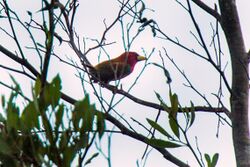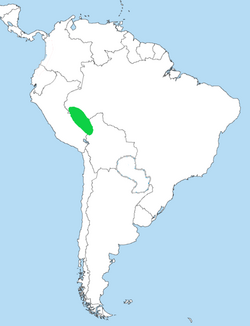Biology:Scarlet-hooded barbet
| Scarlet-hooded barbet | |
|---|---|

| |
| Scientific classification | |
| Domain: | Eukaryota |
| Kingdom: | Animalia |
| Phylum: | Chordata |
| Class: | Aves |
| Order: | Piciformes |
| Family: | Capitonidae |
| Genus: | Eubucco |
| Species: | E. tucinkae
|
| Binomial name | |
| Eubucco tucinkae (Seilern, 1913)
| |

| |
The scarlet-hooded barbet (Eubucco tucinkae) is a species of bird in the family Capitonidae, the New World barbets. It is found in Bolivia, Brazil , and Peru.[2][3]
Taxonomy and systematics
The scarlet-hooded barbet is monotypic.[2]
At times it was thought to be closely related to the red-headed barbet (Eubucco bourceirii) and possibly conspecific, but it is treated now as a full species with no close relatives even within its genus.[3]
Description
The scarlet-hooded barbet is approximately 17 cm (6.7 in) long and weighs 40 to 44 g (1.4 to 1.6 oz). The male's entire head, throat, and upper mantle are red but for a bit of black around the eye and bill. The rest of the upperparts are green. Its lower breast is orange and yellow; it has a gray patch on the side and the flanks are streaked with olive. Most of the female's head is also red, but the throat is yellow. It has an orange band on the upper breast and the rest of the underparts are like the male's.[3]
Distribution and habitat
The scarlet-hooded barbet is found in the upper Amazon Basin where eastern Peru, western Brazil, and a bit of western Bolivia meet. More than half of its range is in Peru. It inhabits bamboo and Heleconia in dense understory, always within approximately 150 m (490 ft) of rivers and oxbow lakes. It can also be found in overgrown gardens near rivers and on river islands. In elevation it ranges from approximately 150 to 850 m (490 to 2,790 ft).[3]
Behavior
Feeding
The scarlet-hooded barbet's diet is approximately 60% fruits such as figs and Cecropia seeds and 40% insects and other arthropods of many kinds. It also eats flowers and nectar. It forages from near the ground up to approximately 11 m (36 ft) by gleaning fruits and probing dead leaf clusters for insects. It joins mixed-species foraging flocks.[3]
Breeding
The scarlet-hooded barbet nests in Peru in July and possibly. Like all New World barbets, it excavates a nest hole, usually in a tree, but virtually nothing else is known about its breeding phenology.[3]
Vocalization
The scarlet-hooded barbet's song is "a fast 'oop-oop-oop-'" [1].[3]
Status
The IUCN has assessed the scarlet-hooded barbet as being of Least Concern.[1] However, "[further] data [are] required on its breeding habits and requirements."[3]
References
- ↑ 1.0 1.1 BirdLife International (2016). "Eubucco tucinkae". IUCN Red List of Threatened Species 2016: e.T22681942A92926828. doi:10.2305/IUCN.UK.2016-3.RLTS.T22681942A92926828.en. https://www.iucnredlist.org/species/22681942/92926828. Retrieved 14 September 2023.
- ↑ 2.0 2.1 Gill, F.; Donsker, D.; Rasmussen, P. (January 2021). "IOC World Bird List (v 11.1)". https://www.worldbirdnames.org/.
- ↑ 3.0 3.1 3.2 3.3 3.4 3.5 3.6 3.7 Short, L.L. and J. F. M. Horne (2020). Scarlet-hooded Barbet (Eubucco tucinkae), version 1.0. In Birds of the World (J. del Hoyo, A. Elliott, J. Sargatal, D. A. Christie, and E. de Juana, Editors). Cornell Lab of Ornithology, Ithaca, NY, USA. https://doi.org/10.2173/bow.schbar1.01 retrieved May 27, 2021
Wikidata ☰ Q588506 entry
 |


